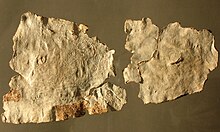
The Larzac tablet is a lead curse tablet found in 1983 in the commune of L'Hospitalet-du-Larzac, Aveyron, southern France. It is now kept in the museum of Millau. It bears one of the most important inscriptions in the Gaulish language.
The inscription is in Roman cursive on a lead tablet preserved in two fragments, dated to about 100 AD. It is the longest preserved Gaulish text, extending to more than 1000 letters or 160 words (an unknown number of lines at the end of the text are lost). The curse tablet was excavated from a grave of La Vayssière necropolis, just north of the village of L'Hospitalet-du-Larzac, close to the ancient Roman road from Condatomagus (Amiliavum, Millau) to Luteva (Lodève), at the time crossing the provincial border between Gallia Aquitania and Gallia Narbonensis.
The text cannot be translated with any certainty, but it is clear that its nature is that of a magical curse, cast in the "world of women", presumably by one group of women or sorceresses against a rival group. The placement of the curse tablet in a tomb is not unusual in the Greco-Roman world; the tomb was considered a gateway by means of which the curse would reach the infernal deities charged with its execution. The fragmentation of the tablet may also be intentional, performed by its original authors, as part of the ritual "burial" of the curse to send it on its way to the underworld. The magic invoked is clearly malicious, of a nature well attested from other parts of the Celtic world, notably Irish mythology. Sisterhoods of sorceresses or witches are also known to have existed in ancient Gaul on the authority of ancient ethnographers; thus, Pomponius Mela (III, 6, 48) records a college of nine priestesses capable of invoking tempests and adopting animal form among the Osismii, while Strabon (IV, 4, 6) is aware of a convent of women of the Samnitae possessed by Dionysus, installed on an island of the Loire estuary.
Both the context of the curse tablet and the names of the women listed as targets of the curse reflect the syncretic culture of Roman Gaul at the end of the 1st century. The name of Severa Tertionicna, the "head witch" targeted by the curse, consists of a Roman cognomen Severa and a patronymic which combines the Roman cognomen Tertio with the Gaulish -ikno- suffix.[1]